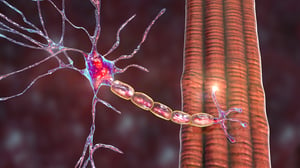The focus is on sphingolipids, molecules that appear to play a major role in the disease. If studies are confirmed it may pave the way for new and more effective drugs.
Researchers at the Swiss Federal Institute of Technology in Lausanne and Helsinki University, together with other Northern European colleagues, have identified one of the possible 'drivers' of muscular dystrophy, a genetic degenerative disease that leads to a gradual loss of muscle mass, then to disability and - in the most severe cases - even death. In particular, researchers have demonstrated that a group of fatty acids normally produced by the body, sphingolipids, which are already responsible for transmitting nerve signals and many other functions, play a major role in dystrophy, and are therefore likely to be a very interesting target from a therapeutic point of view.
It is hoped that in the near future, there will be more specific and effective drugs than those currently available, which may not stop the disease but slow down its progression and improve patients' quality of life somewhat.
Researchers have in fact already identified and tested a possible drug against sphingolipids - myriocin (a natural molecule extracted from mushrooms) - on laboratory animals with seemingly encouraging results. Further studies, including on humans, will obviously be needed to confirm these positive effects.
The study phases
But let's start in order. Firstly, researchers noticed a series of abnormalities linked to sphingolipids in laboratory animals affected with muscular dystrophy: in particular, a higher than normal concentration of intermediate substances that lead to sphingolipid synthesis.
As reported in Science Advances, the researchers then decided to 'test' myriocin, which is already used to treat rare diseases, and realised that it was able to block an enzyme essential for sphingolipid synthesis. Deactivating this enzyme, and thus stopping the production of sphingolipids, also stopped the loss of muscle tissue (typical of muscular dystrophy), and stabilised calcium metabolism at the same time. It also reduced inflammation in muscle fibres and the immune system cells that cause it (macrophages) returned to a dormant state.
So researchers have shown that, at least in animals, the chain of events leading to the synthesis of sphingolipids definitely plays a part in dystrophies and therefore offers numerous possible targets. Myriocin, as we mentioned before, is already available, and has proved to be very effective, more so than the corticosteroids currently used to date to treat patients, but other molecules could also be studied in the future.
A group of diseases
It is worth remembering that the term 'muscular dystrophy' actually refers to a group of diseases, all of which have the same specific gene mutation that ‘produces’ a protein called dystrophin.
This molecule acts as an anchor between two components of muscle cells: the cytoskeleton (the network of filaments and tubules that extend into the cytoplasm - the 'liquid' part of the cells) and the membrane surrounding muscle tissue fibres. When dystrophin does not work properly, the whole cell is radically affected because its structure is compromised, together with calcium metabolism. The result is that chronic inflammation sets in, and morphological changes also occur, with scarring and fibrosis forming in various organs.
Around half of all dystrophy cases involve Duchenne muscular dystrophy, which is also the one that the researchers in Lausanne focussed on. Sphingolipids appear to play a major role in the onset of damage. This is why new studies will soon be carried out to identify increasingly selective and powerful substances able to inhibit them.

